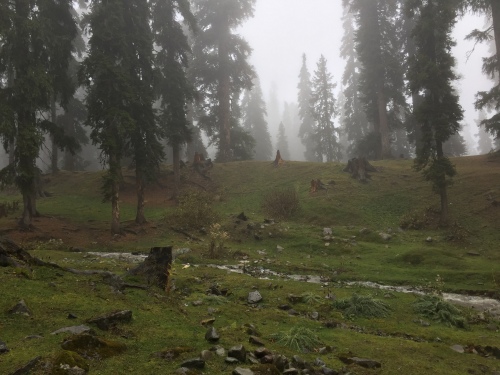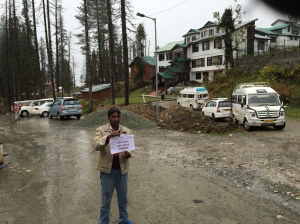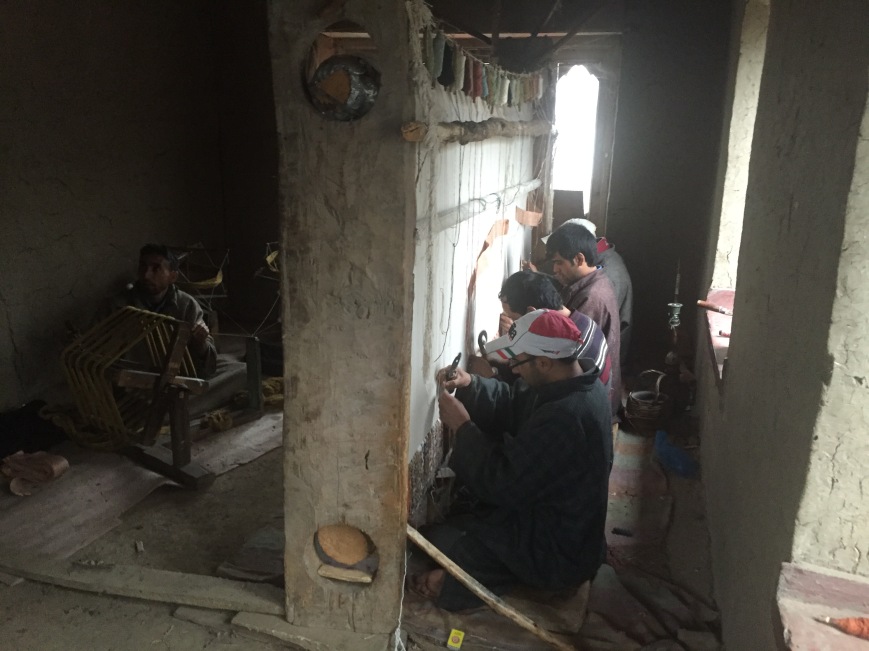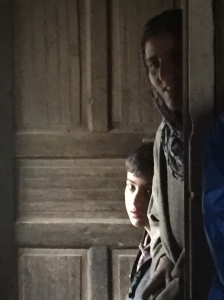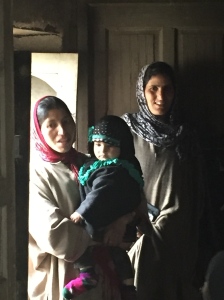Given that in all my trekking years this was never on my list, I have now done it twice.
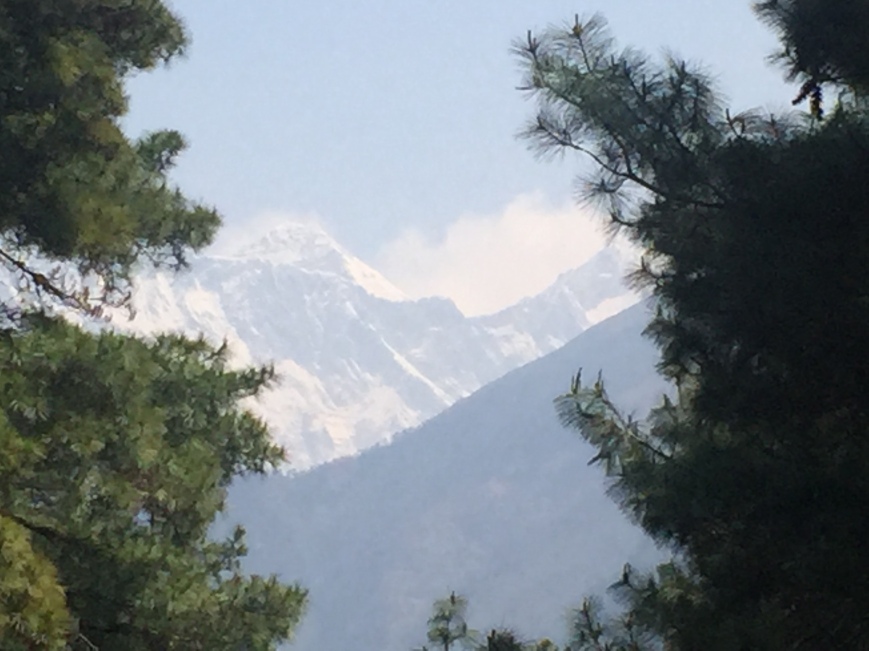
To me, it seemed more a trophy trek than an exploration. It is still a trophy trek for many, however, it is also an exploration of a valley of amazing beauty. The opportunity to be surrounded by some of the world’s highest peaks. A look into the local culture and enterprise of an intrepid people that inhabit the villages along this route. What stays in my mind are the many women of quiet substance that run the lodges that provide such comfort to weary trekkers, under harsh and difficult conditions. Everything is carried up here by porter or pony. First, to build some of these lodges with their crazy luxuries. Then to cater and supply almost anything that one could ask for. The logistics, the planning, the costs – and the goodwill, it is awesome.
It upsets and angers me when I see or hear trekkers being rude, demanding and unreal about what they are getting and what they assume they should get. Every little bit in this area is a bonus to be thankful for.
‘This cake is really dry.’ complains someone sitting in the bakery at Dingboche. At 4300 m, the fact that you can sip a fresh brewed coffee and eat a melting chocolate brownie, in a lovely warm space, is an unheard of luxury. You bless yourself and the hard working couple who smilingly make this possible and swallow the, really not dry cake, with a smile and look out at the majesty surrounding you. Marvel at the fact that you are here and able to be a part of it all.
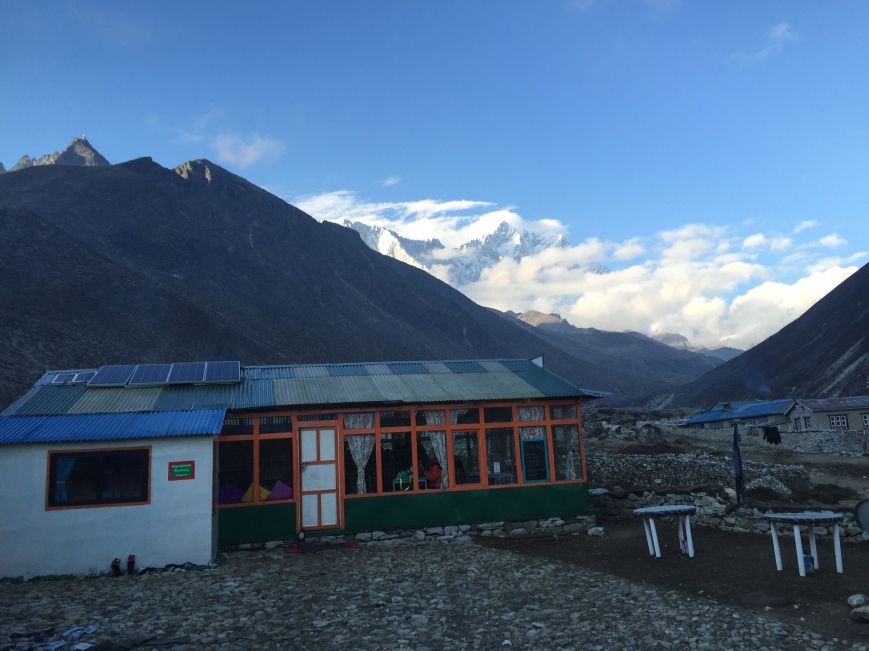
The bakery at Dingboche
There are many day by day accounts of this trek with heights and distances and trail features. This is just a rambling from both my journeys.
The groups I led were varied. In 2014, we had a majority of women and two men. That was divided by the physically young ones and the other young ones. So though the departure times every morning were the same, the arrivals greatly varied. Also, we did this trek as per the regular itinerary, which did not work at all with the average Indian trekker – we are not the people that go off every weekend hiking up some hill in our backyard and prone to long walks in all weathers.
All those western traditions that make hardy walkers that step out briskly, seemingly conquering those ‘little bit up, little bit down – nepali flats’, with supreme ease. Of course, they succumb to the altitude same as us. Which is what many of that 2014 group did at various stages. It was mostly due to exhaustion, carrying too much and not being sufficiently hydrated. Most people do not take the hydration seriously. There is also the problem of – ‘where will I pee?’ In the loos of the many tea houses that abound, behind a rock, a bush, a tree. You seriously have to lose that inhibition and drink lots and pee lots. However, we all got to Gorakshep, which is a great achievement in itself.
This year, 2016, I had, again, a very varied group. Varied ages, varied purposes for the trip and disparate personalities. They more or less came together after a few days. However, half of them felt enough had been achieved by the time they got to EBC and chose to shift their itinerary and helicopter out after descending 2 days and getting in an extra night at the beautiful ‘Rivendell lodge.’ The other half completed the trek back to Lukla. Where bad weather finally delayed our departure, whereby most of them chose to helicopter out too.
There is nothing like a long, exhausting, pushing the boundaries expedition in an unfamiliar habitat to showcase human nature at it’s most exposed. There is also nothing that equalises people better. When your only option is get with it or get out, and sometimes getting out may not be so easy – you get to see people at their best, there worst and everything in between.
On this route, however, that little red helicopter does manage to get almost everywhere in double quick time. As was evidenced by the one crisis we encountered this trip. One person with acute AMS developing at Gorakshep. Snow falling and low visibility meant the helicopter may not be able to come in. There was no way to get her down in that weather on foot or horse. The terrain is too treacherous to be carried or to ride through that huge, boulder strewn morraine. Besides it was snowing. Administering oxygen helped as a stop gap and we would have had to keep it up through the night if no evacuation happened. I have to say, I prayed very hard for a clear window for that helicopter and badgered the insurance company, the helicopter company and all the Gods I know, like a nagging fishwife. That saviour of a helicopter appeared as soon as a tiny window of weather allowed and off she flew to the great relief of all concerned. Those pilots must be earning many points with whosoever up there is counting.
My highlights –
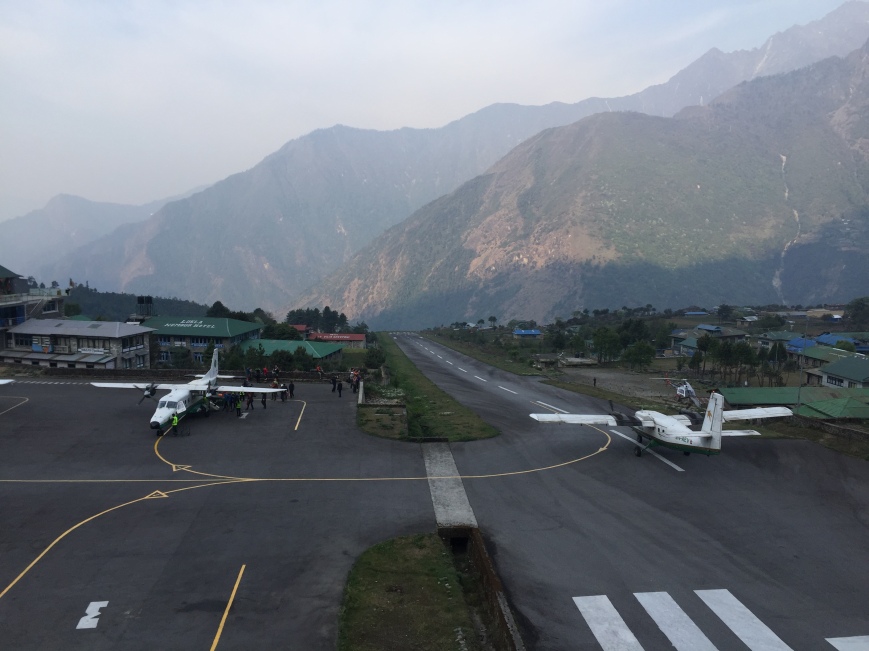
Lukla airport
The most amazing flight into Lukla. The little aircraft, propellors whirling, flying lower than the towering mountains. Slipping over a pass almost grazing the trees and being buffeted by the cross winds to land at the edge of a cliff. I imagine my father must have felt a little of the same when landing on his aircraft carrier. Except we could not run off the runway – just run into the mountain, because the runway sloped up the hill and just as you thought you would hit, it U turns onto the apron and the craft slows – disgorges one lot of passengers, immediately loads another waiting group. Whirrs up and off it goes down that slope and launches off the edge. A quick turn around and they do this in relays all morning as long as the weather holds. Those pilots have got to be good!
What a beginning to a journey.
Lukla is a little village of red green and blue roofs most of which are family run lodges.
The first introductory walk taught us about that ‘little bit up, little bit down – Nepali flat’.
You hit the Dudh kosi river and are walking along it. Every few minutes you find pretty tea houses with flowers in pots, little gardens, growing vegetables and all so clean. It is remarkable. There are large trash bins along the way for segregated rubbish. A pretty, pretty valley. I am going to discover if these are traditional families who have converted their homes or have more come and settled this road to Everest.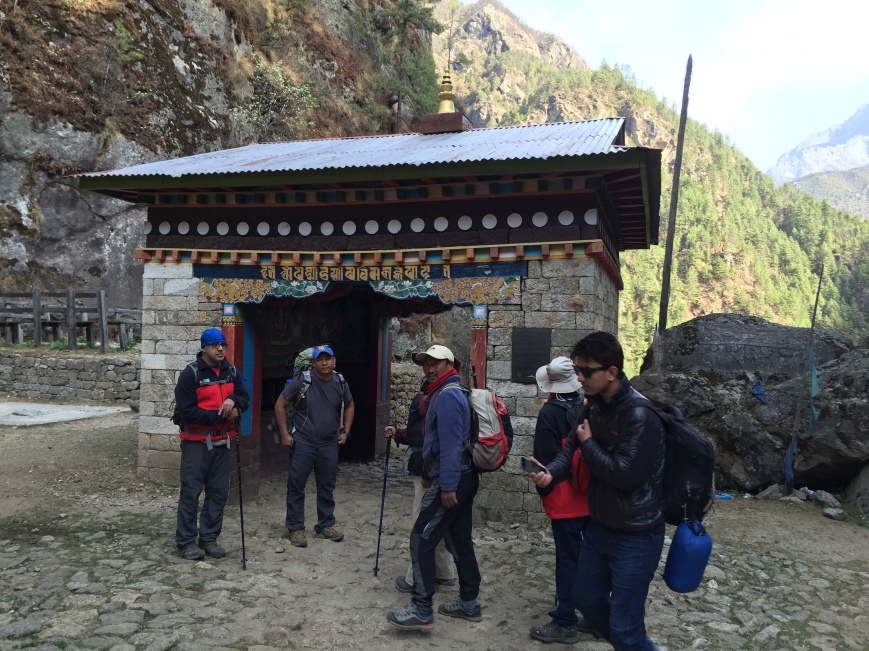
On our first trip we stopped at Phakding which was a 4 hour walk. This made our next day a hugely challenging one. The morning was beautiful. We walked along the Dudh Kosi, climb a little, drop a little, then climbed and suddenly came to this gate. Decorated and painted in true mountain style, making sure you realise the significance of the great space it announces – the Sagarmatha National Park. On passing through an amazing vista of the valley fell below us – and of course the path fell straight down the mountain to the river far, far below. So that’s what we did, rolled down the path trying to keep the gospels of downhill walking in mind.
Many long years ago a village woman in the hills carrying that huge load of grass on her head helped me learn; keep the spine straight, hang yourself off the sky and swivel your hips – great way to save the knees and looks rather exotic too. We now call it the ‘Garhwali Matak’.
Well we descended to the bottom and hit the Dudh Kosi to walk along this raging river that originates from the Khumbu glacier and the legendary mountain, Everest.
Our group was divided by age and ability – the ‘young adventurers’ who forged on ahead and we the ‘slow and steadies’ who are diligently practicing the ‘Nepali Shuffle’, another gem of information gleaned from an old Nepali porter on a long ago trek. Take very small steps, never climb a high step if you can do a shorter one – and always walk with your breath. So the ‘Nepali shuffle’ and the ‘Garhwali matak’ allow me to walk many miles in the mountains with great ease. It is something I try and impart to anyone who walks with me – it has been a large part of my enjoyment of the mountains – they make for tireless walking which you can keep up for long hours.
So we shuffle and try to spot the young ones up ahead only to see the marvellous sight of two unlikely looking bridges, suspended in space high above the valley. Do we have to cross those and try and climb that ever rising path that goes straight up the mountain across the bridge? We surely do and the sight makes many a heart stop. What feat of engineering created these?
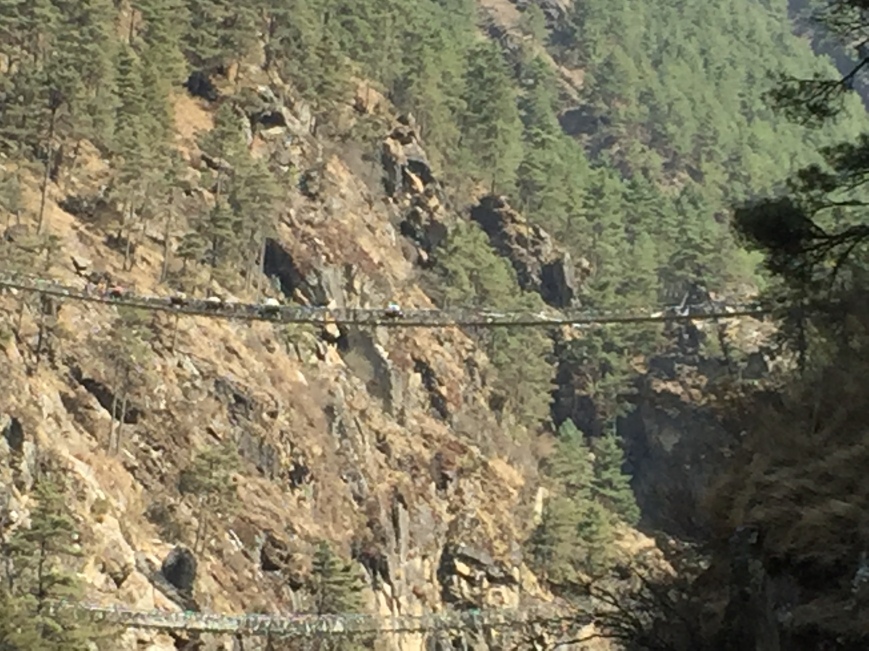
Bad photo of an awesome bridge!!
That bridge was awesome. Blowing wind tunnel of a gorge, swaying bridge with prayer flags flying. Crossing it was a hat holding, heart holding affair, and after came that awful, continuous climb.
Time out to introduce our great guides for 2014 : Kudumbir, Nima Sherpa and Bir Bahadur.
Kudumbir is a young man of about 27 years who runs up and down to Everest Base Camp about six times a season. ( After getting us safely on the flight back – he went back up to run the Everest Marathon.) He knows everything about the area, mountains, well being et al. An extremely well trained, well spoken, fit young man who gauged our group immediately – the ‘Hot shot young bloods’ and the ‘Aunties’.
With him are the other two, Nima speaks some English and is a great guide with a sense of humour. Bir is a trainee who has still to become proficient in communication but knows the trail like the back of his hand, and they are all willing, smilling and so hard working – it is a safe, happy feeling to be with them.
This year we had a string of support staff – all smiling and willing and guides who worked very hard. The quality that comes from having the right certification and knowledge, however, is supremely important in these terrains. With Kudumbir, I had very little to do. This year, though the trek was easier, I worked harder.
To return to the story. Somehow we finally did get to Namche. We had to leave one sitting on a tree trunk. KB came running down because I decided to call for a horse and he stayed and took care to bring her up. The rest of us plodders, put one foot before the other to finally see: first the forest check post, then a series of stairs once again and finally after many stairs – washing women – The Irish Pub – many exciting shops and at long last the NAMCHE HOTEL – just short of dark.

Namche Bazaar
This year, we did not stop at Phakding that first day, but continued another 3 hours, easy walking to Monjo. Thus starting our walk for Namche the next day, just short of that lovely Sagarmatha gate and getting to the great NAMCHE HOTEL with ease, in good time for lunch!! And what a hotel! – you walk straight into this warm dining room, great rooms with attached loos. ELECTRIC BLANKETS! Such a blessing to aching backs and legs.
At the entrance to Namche the washer women and their little ghats are gone. In their place are being built gates and structures of ‘importance’ to announce the entrance to Namche.
I have trekked all over the Himalaya for many years, never have I trekked into a place like this – mid trek.
Namche Bazaar must have been a tiny village, today all but two homes are lodges – and good ones. There are shops that can kit you for a complete expedition, a bakery that sells Strudels to Chocolate croissants as good as any big city. It’s a thriving little community which runs for about 6 months of the year and seemingly does good business.
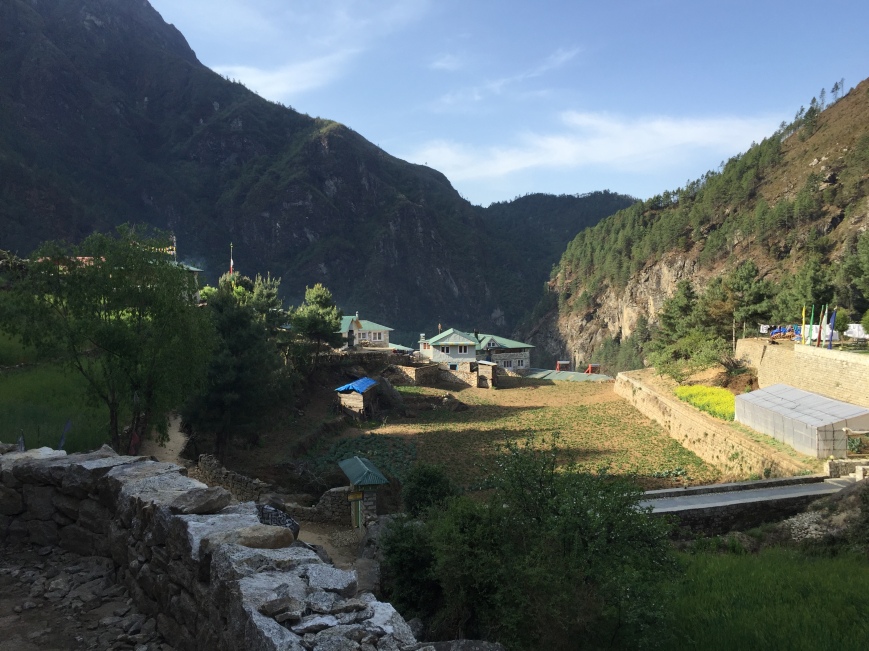 What strikes one along this whole route is the cleanliness, the care for the environment, litter sorting, organic farming. I spoke with this lovely lady called Maya who owns and runs the Namche hotel – my curiosity about local families or outsiders was satisfied. They are all local people who have converted their homes and created good businesses. They send their children to Kathmandu and even to India to study. The children come home to help with the business. There is a community movement for keeping the area clean and carting all the waste out. They grow their own crops of vegetables – potatoes, greens, onions, garlic.
What strikes one along this whole route is the cleanliness, the care for the environment, litter sorting, organic farming. I spoke with this lovely lady called Maya who owns and runs the Namche hotel – my curiosity about local families or outsiders was satisfied. They are all local people who have converted their homes and created good businesses. They send their children to Kathmandu and even to India to study. The children come home to help with the business. There is a community movement for keeping the area clean and carting all the waste out. They grow their own crops of vegetables – potatoes, greens, onions, garlic.
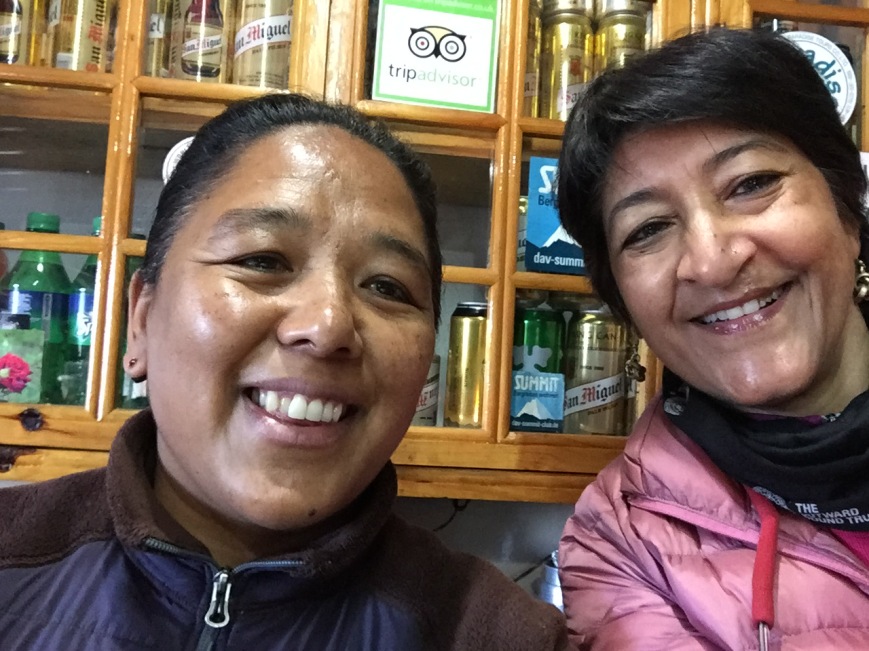
Maya of the Namche hotel
We all spend an acclimatising day at Namche and walk up to the viewpoint to look at Everest, Ama Dablam and the grand array of high peaks. The highlight, for me, was to actually see a Monal pheasant in the wild – the first I have ever seen – it was a wonderfully healthy specimen of glittering jewel colours, that just regally walked away from our crowd of ignorant, noisy viewers.
Then is was like a holiday – shopping, bakery, wifi and a jolly good foot massage from a young man who went all the way to Sri Lanka to learn the art – his name he said was Simba, later it became Sim Bahadur. He is across the street from the German bakery for any who want to try him.
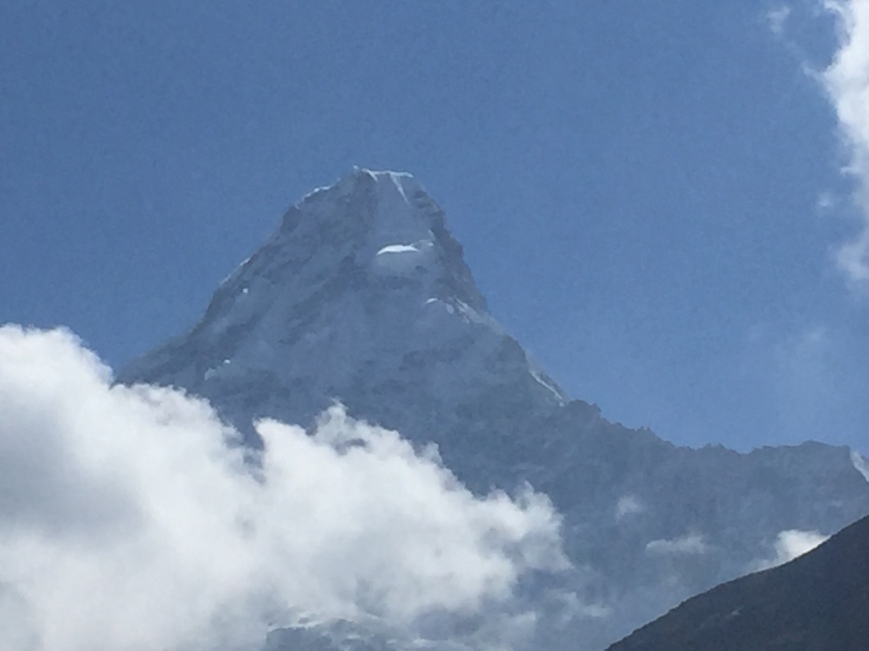
Ama Dablam ( I only do phone photos!)
The next day is just a marvellous walking day! 10 hours of it but gaining only about a 1000 feet – from Namche to Deboche via the Tengboche monastery. It was level and smoothly paved, ( a most well set up track ) around a bend suddenly the huge mountain vista opens – Everest, Llotse, Ama Dablam that stayed with us the whole day as we walked through pine, juniper and rhododendron – an explosion of sights and smells. It was the usual Nepali flat – little bit up and little bit down – though it felt more like a lot of up and down. Down, down, down to the river, across another of those long, swaying bridges. Lunch at a tea house by the water turned prayer wheels of Pungi Thanga and then up, up and up to the Tengboche monastery. Sit and listen to the monks chanting and playing their big resonant drums. All climbers of Everest stop here for blessings and so did we. Sitting in that prayer room was a transportation. The sounds fill you up and soar you out over those splendid mountains – you can manage any feat at that moment, there is so much pure energy resonating through you.
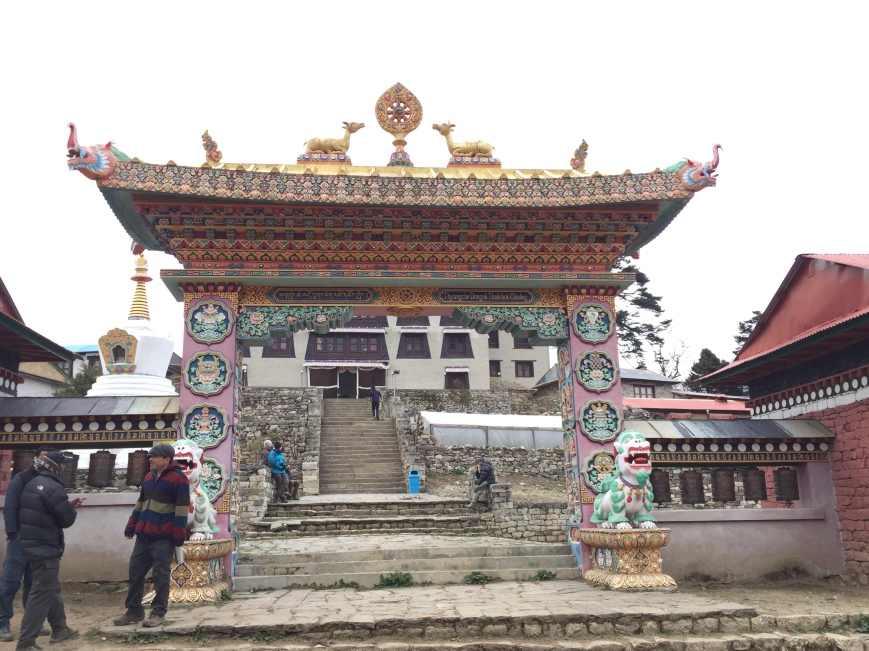
Tengboche Monastry
From the monastery down to the Rivendel lodge was a fairyland of pink, flowering rhododendrons, interspersed with glowing white and gold Bhojpatra. A magic walk to the beautiful lodge. The dining room was warm and welcoming with the inimical wood burning stove – wooden benches and tables – really good food ( beefsteak for Rs.950 and Johnny Walker whisky at Rs.400) and comfortable beds once more.
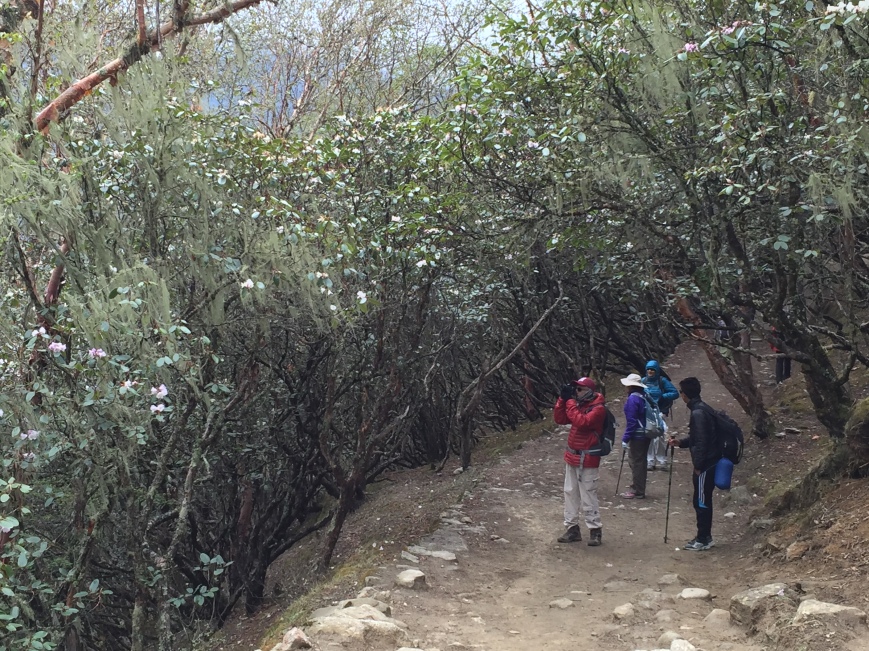
Rhododendron and Bhojpatra
No one mentions how beautiful this walk is. The view from my window gave me Everest, Llotse and Amadablam. The lodge sits in a lovely meadow surrounded by glowing Bhojpatra or Himalayan Birch, the peeling bark shining gold in the sunlight. Trailing fronds of lacy moss hang from the branches. The rhododendrons are a canopy of white and pale pink, sprinkling petals on the enchanting path and making a fairy scene. You walk through this forest, with the big roots of the trees criss crossing the path, prayer walls and then the river. The big bridge lies broken and atilt – evidence of the power that nature often displays. A smaller bridge fords the river and the dry, sandy trail goes up the valley till it emerges onto the early moraine of the Khumbhu Glacier. Above the tree line, the juniper turns scrubby and gnarled, and the valley opens up with the river breaking into various silver streams below. A meandering walk gets us to Dingboche – a spread of roofs watched over by the stupa – across the valley from Ama Dablam.
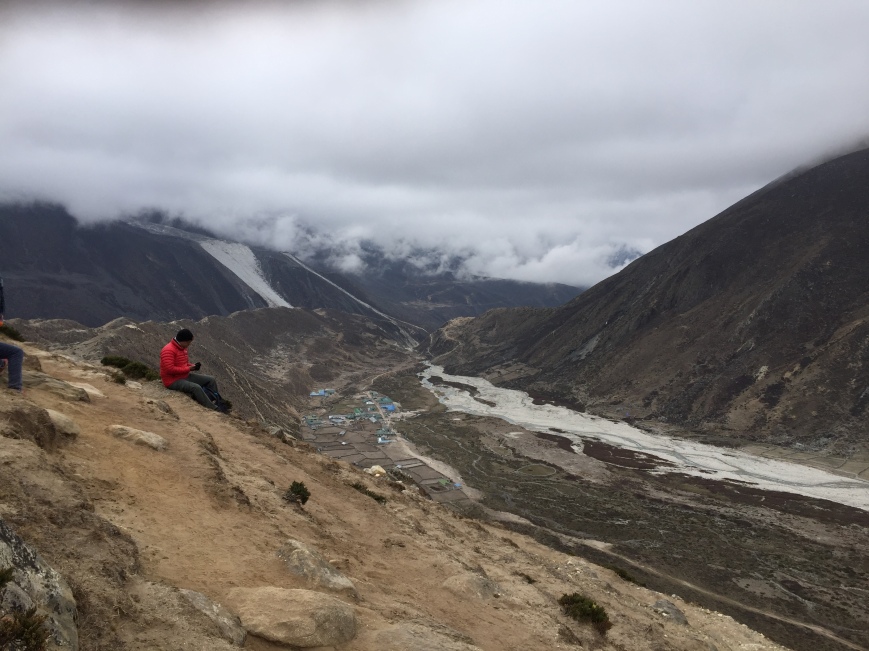
The Debochhe, Pheriche area
From here on, you are in high, high mountains – the walking is slower, the breath is shorter as are tempers. However the vistas are unsurpassable! Ringed with mountains, cloud shadows march along shielding you from the hot sun. Mists rise and make a wonderland to stop and stare at. Which the breath makes very necessary – anyhow. The terrain now is glacial moraine, boulder strewn, harsh and rather mindless. A very steep and tiring climb brings you out at the memorial to all who perished trying to climb the mountain of mountains. If the wind chill and fatigue allow, this is a great place to spend some time reading the inscriptions and spending a moment of silence in commemoration. It’s probably better done on the way down than up.
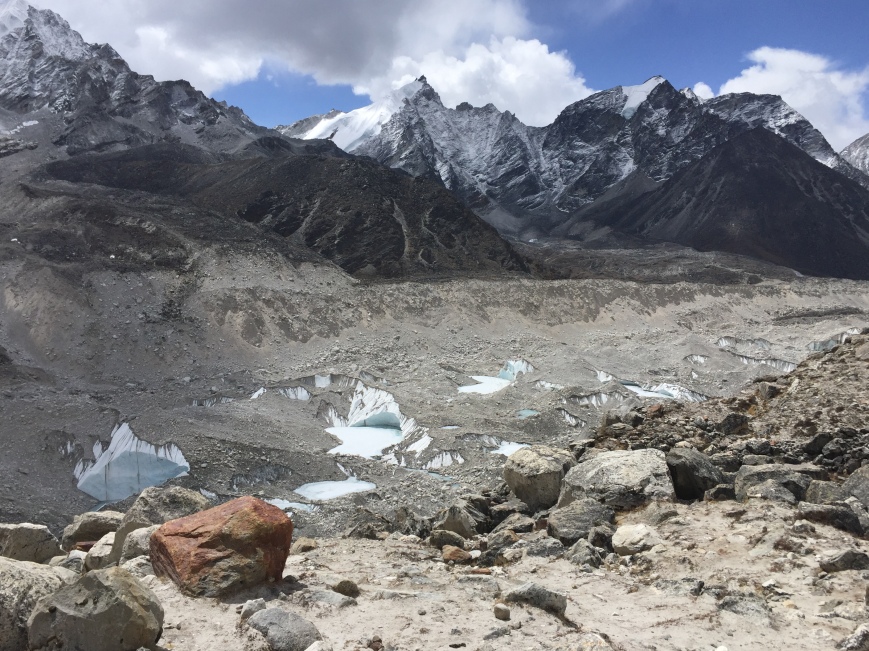
Khumbhu glacier
The most amazing sight is getting over a rise and suddenly seeing the whole of that huge river of ice spread out before you all the way up to the orange tents of the base camp and that phenomena – the khumbu ice fall. Littered with debris, cliffs of blue ice, milky blue lakes, ice shards like buildings, spiking up from the mass and all of it creeks and groans if you stop and listen enough.
This is also the area to find the snow cocks with their guttural glocking. Himalayan thrushes with their tuneful whistles abound. The call of the marmot can be heard and the pikas with their shy inquisitive faces peep out if you sit still enough. Myriad flowers of most exotic shape and colour bloom all over, potentilla, gentians, delphiniums, anemones, asters, primulas and a hundred others that I only know as scientific names that I cannot recall. You just have to make the time to sit and stare.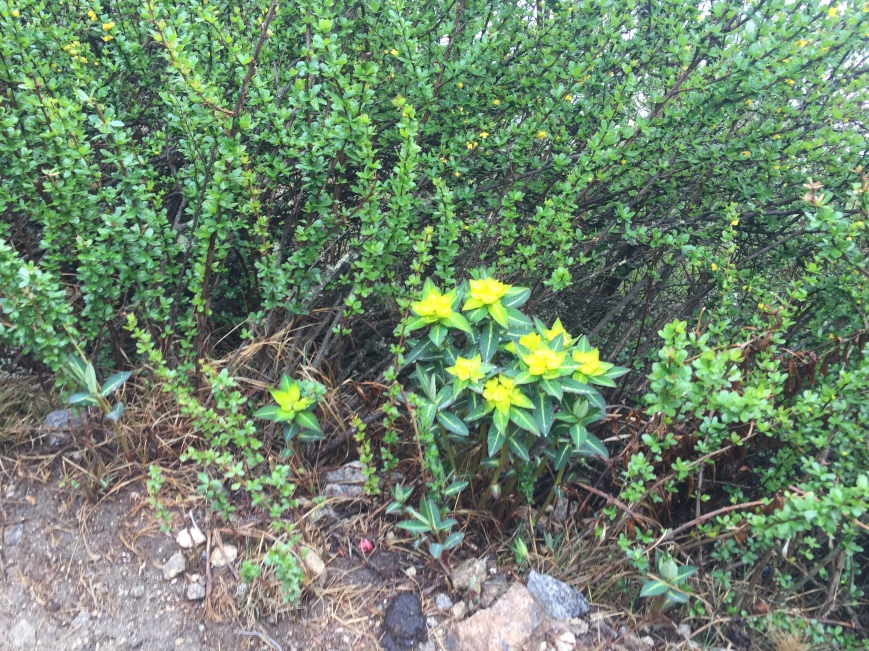
In 2014 there were no climbers at EBC, no city of orange tents, not a soul, but the cairn of rocks with the fluttering prayer flags. Thus, going and touching that barren wilderness, struggling over those enormous boulders for a photograph of black rocks, it hit me so forcefully, why would i want to do this? Stopping at every two steps, exhausted beyond measure from waking at 4.00 am and walking from Lobuche to Gorakshep in bitter cold, with icy winds and darkness. Getting there, having breakfast and heading out to this empty EBC. It was done by half our number and the rest were satisfied by having gotten to Garakshep at all.
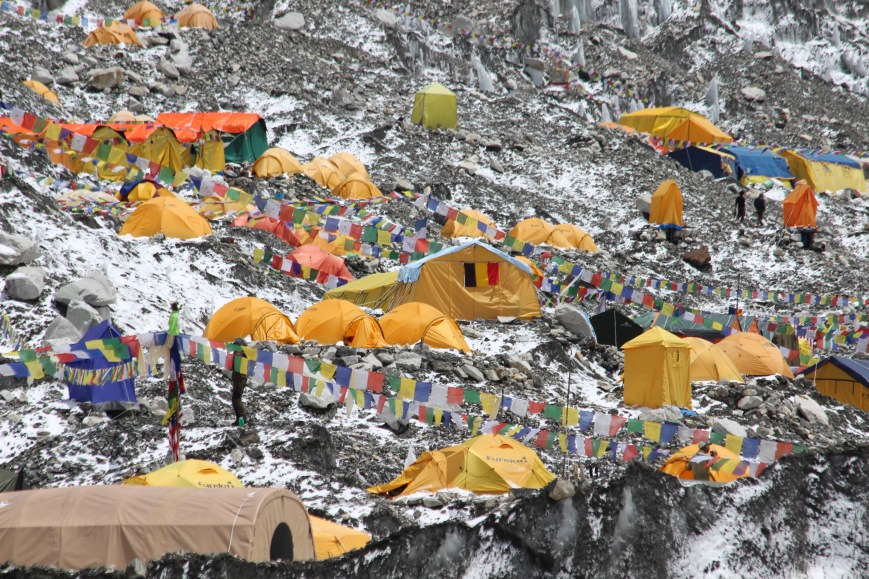
EBC tent city photo by Amit Singhal
This year it was different, it’s still an unassuming area of dirty black rocks – but it was littered with those little orange tents, pitched higgledy piggledy wherever a tiny flat could be found. All the group did it. But it was because we had a rest day to do it in. Not straight out of Lobuche and back down. Snowy ground, but a clear, clear morning, everyone fit and ready to go, other than the one person who we had to finally evacuate. There were climbers to be met, stories exchanged and lots of photos and excitement. Perhaps this is the whole purpose of EBC, if there is one?
We returned to the tragic news of the death of climbers that were met at EBC. May they rest in peace.
George Mallory said many different things about climbing Everest – but the last few words of this quote resonate:
“For the stone from the top for geologists, the knowledge of the limits of endurance for the doctors, but above all for the spirit of adventure to keep alive the soul of man.”
― George Mallory











 What strikes one along this whole route is the cleanliness, the care for the environment, litter sorting, organic farming. I spoke with this lovely lady called Maya who owns and runs the Namche hotel – my curiosity about local families or outsiders was satisfied. They are all local people who have converted their homes and created good businesses. They send their children to Kathmandu and even to India to study. The children come home to help with the business. There is a community movement for keeping the area clean and carting all the waste out. They grow their own crops of vegetables – potatoes, greens, onions, garlic.
What strikes one along this whole route is the cleanliness, the care for the environment, litter sorting, organic farming. I spoke with this lovely lady called Maya who owns and runs the Namche hotel – my curiosity about local families or outsiders was satisfied. They are all local people who have converted their homes and created good businesses. They send their children to Kathmandu and even to India to study. The children come home to help with the business. There is a community movement for keeping the area clean and carting all the waste out. They grow their own crops of vegetables – potatoes, greens, onions, garlic.







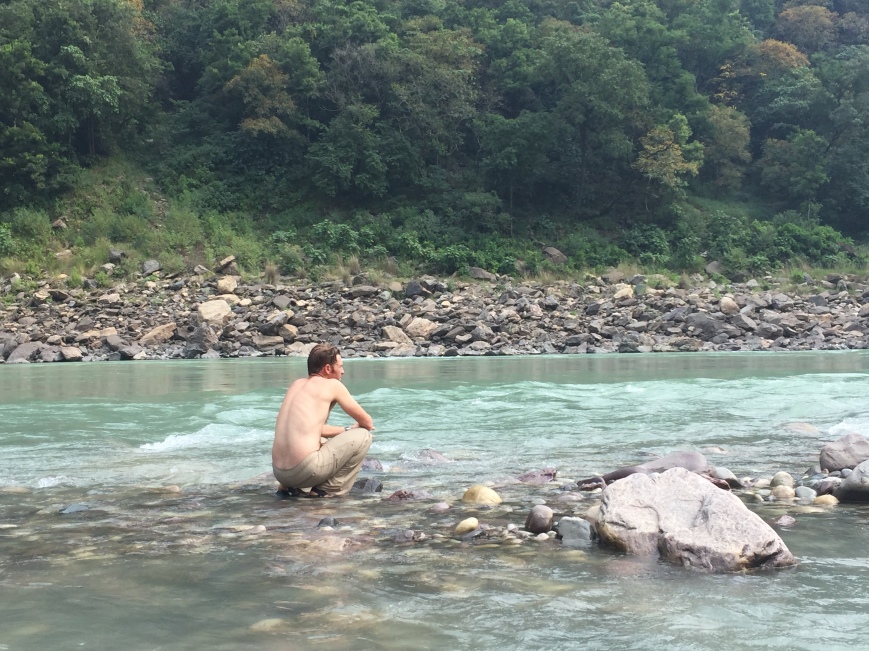 Lonely – the heart or the mind? Neither actually, physical loneliness is what I think it boils down to. The heart can be full of love, the mind can be happy with the day, the flower, the circumstance, a book, a movie, the very air.
Lonely – the heart or the mind? Neither actually, physical loneliness is what I think it boils down to. The heart can be full of love, the mind can be happy with the day, the flower, the circumstance, a book, a movie, the very air.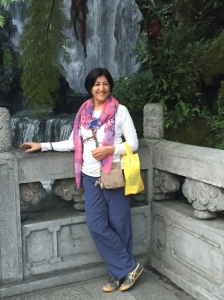
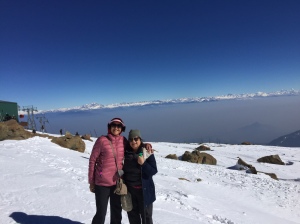 magical sunset.
magical sunset.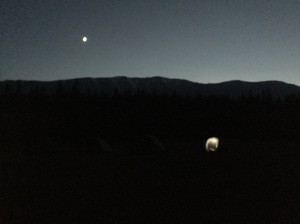
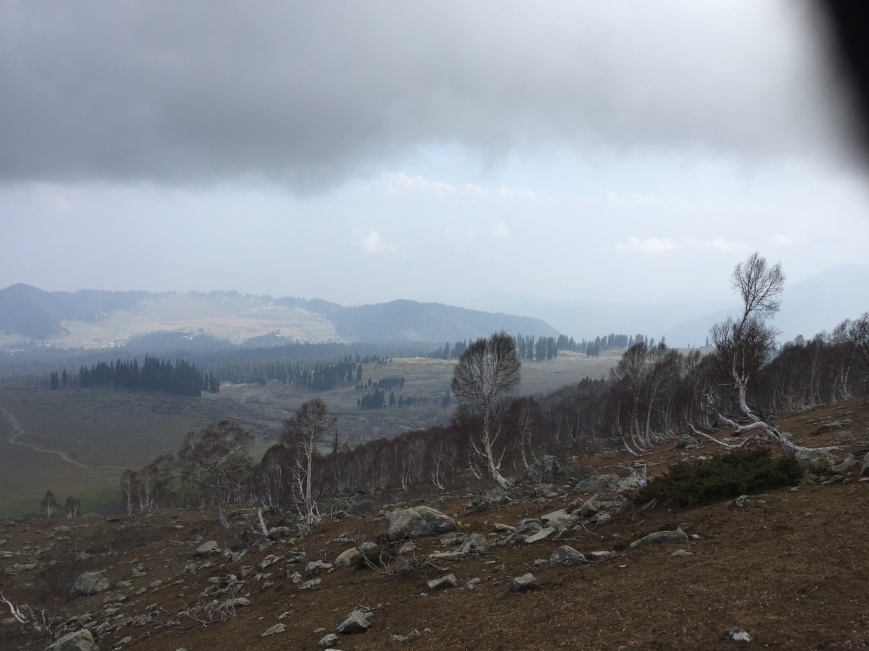

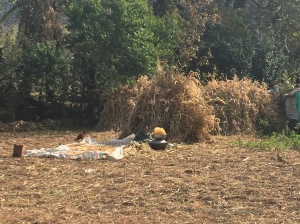
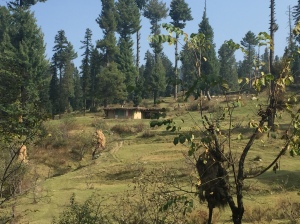
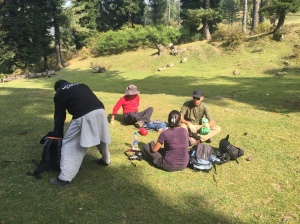
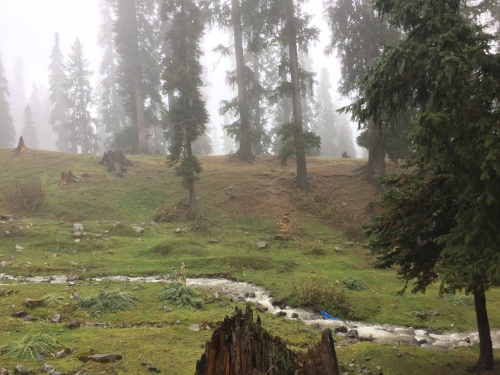

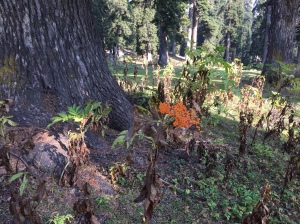
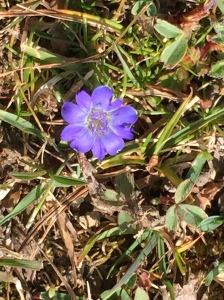
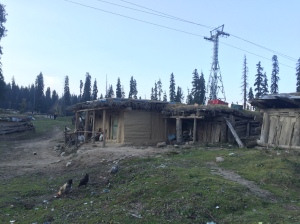
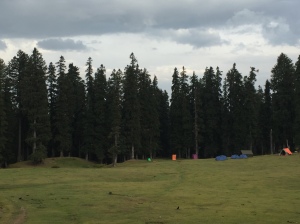
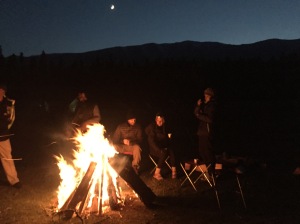
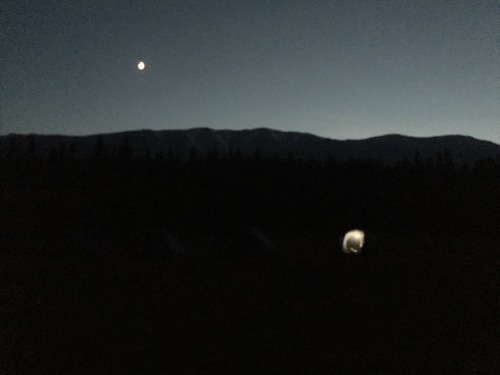
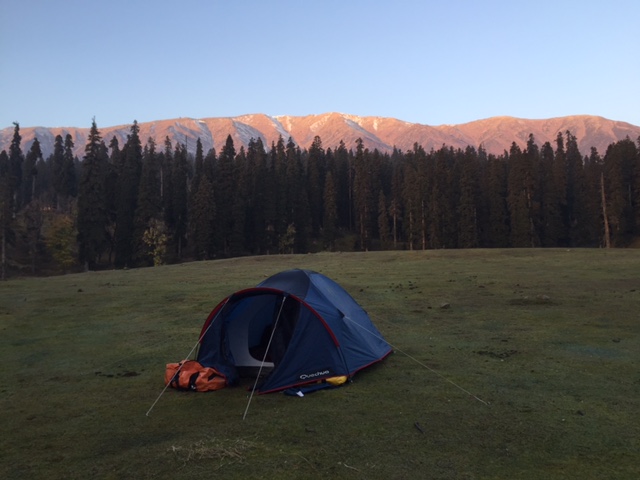
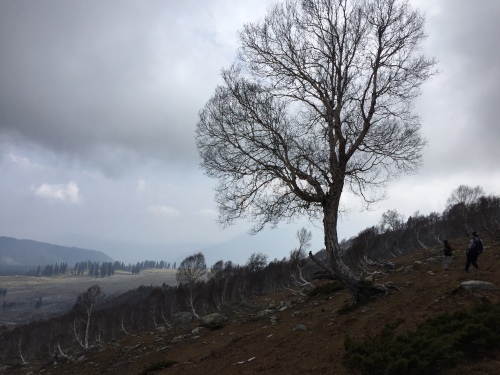
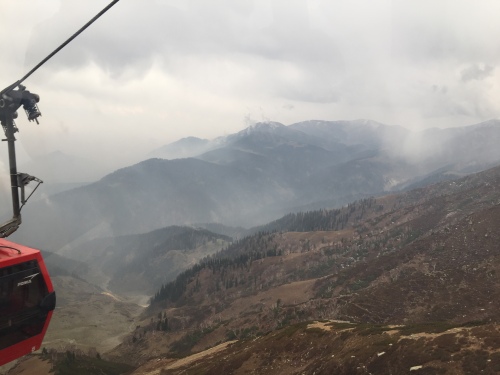 By the time we reached the top it was hailing and raining and an absolute white out. The frozen lake would have to wait for another time, when perhaps the meadows would be a burst of interesting wild flowers to make that trudge more palatable.
By the time we reached the top it was hailing and raining and an absolute white out. The frozen lake would have to wait for another time, when perhaps the meadows would be a burst of interesting wild flowers to make that trudge more palatable.